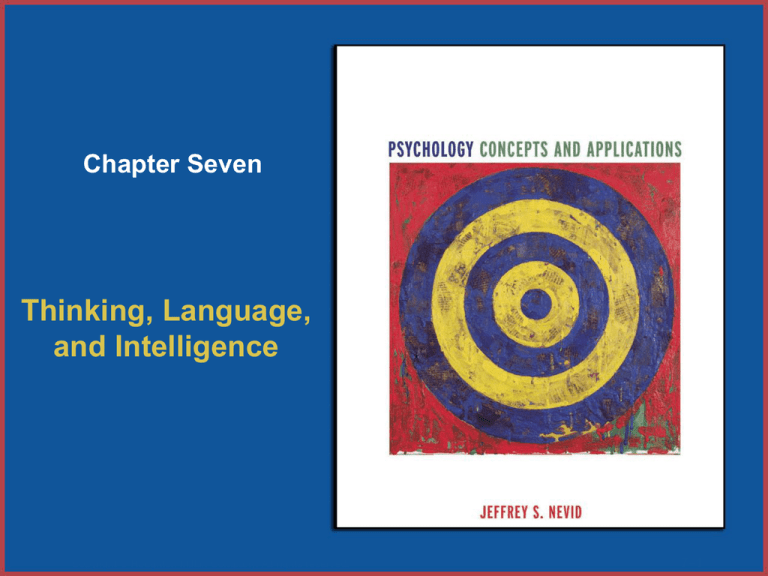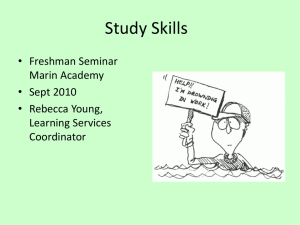
Chapter Seven
Thinking, Language,
and Intelligence
Copyright © Houghton Mifflin Company. All rights reserved.
7–1
Did You Know That…
• Albert Einstein used visual imagery in
developing his theory of relativity?
• An apple is more quickly recognized as an
“apple” than as a “fruit”?
• Alexander Graham Bell used an analogy
based on the human ear in developing the
design for the first telephone?
Copyright © Houghton Mifflin Company. All rights reserved.
7–2
Did You Know That… (cont.)
• A commonly used rule of thumb could lead
you to make a bad decision of which movie to
attend?
• A gorilla participated in an online “chat”?
• A psychological test can be reliable but not
valid?
Copyright © Houghton Mifflin Company. All rights reserved.
7–3
Did You Know That… (cont.)
• A leading psychological theory of intelligence
proposes not one, but many different
intelligences?
• The closer the genetic relationship between
two people, the closer their IQ scores are
likely to be?
Copyright © Houghton Mifflin Company. All rights reserved.
7–4
Module 7.1
Thinking
Copyright © Houghton Mifflin Company. All rights reserved.
7–5
Module 7.1 Preview Questions
• What is cognitive psychology?
• What is thinking?
• What are the major types of concepts people
use, and how are they organized?
• What can we do to solve problems more
efficiently?
• How do cognitive biases influence decision
making?
• What cognitive processes underlie creative
thinking?
Copyright © Houghton Mifflin Company. All rights reserved.
7–6
Cognitive Psychology
• The branch of psychology that focuses on
how we acquire knowledge about the world.
• Cognitive psychologists investigate:
–
–
–
–
Thinking
Information processing
Language
Problem solving
Copyright © Houghton Mifflin Company. All rights reserved.
7–7
What is Thinking?
• The mental representation and manipulation
of information.
• Information is represented in the form of:
– Images
– Words
– Concepts
Copyright © Houghton Mifflin Company. All rights reserved.
7–8
Mental Images
• A mental picture or representation of an
object or event.
• Ability to hold and manipulate mental images
aids with cognitive tasks.
Copyright © Houghton Mifflin Company. All rights reserved.
7–9
Figure 7.1:
Mental
Rotation: Are
the Objects
in Each Pair
the Same or
Different?
Objects in pairs a
and b are the
same; those in
pair c are
different.
Copyright © Houghton Mifflin Company. All rights reserved.
7–10
Concepts
• Mental categories we use to group objects,
events, and ideas according to their common
features.
• Functions
– Helps bring a sense of order to the world.
– Makes us better able to anticipate or predict future
events.
– Help us to respond more quickly to events.
Copyright © Houghton Mifflin Company. All rights reserved.
7–11
Types of Concepts
• Logical Concepts: Has clearly defined rules
for membership.
• Natural Concepts: Membership rules are
poorly defined or fuzzy.
Copyright © Houghton Mifflin Company. All rights reserved.
7–12
Figure 7.2: Hierarchy of Concepts
Copyright © Houghton Mifflin Company. All rights reserved.
7–13
How Do We Learn to Narrow
and Refine Concepts?
• Positive Instance: Exemplifies the concept
• Negative Instance: Does not fit the concept
Copyright © Houghton Mifflin Company. All rights reserved.
7–14
Problem Solving
• Cognitive process using mental strategies to
solve problems.
• Insight believed to result from restructuring a
problem.
Copyright © Houghton Mifflin Company. All rights reserved.
7–15
Figure 7.5: An Insight Problem
Source: Metcalfe, J. (1986). Feelings of knowing in memory and problem solving. Journal
of Experimental Psychology: Learning, Memory, and Cognition, 12, 288-294.
Copyright © Houghton Mifflin Company. All rights reserved.
7–16
Figure 7.6:
Solution to the Insight Problem
Copyright © Houghton Mifflin Company. All rights reserved.
7–17
Problem-Solving Strategies
• Algorithms: Step by step rules
• Heuristics: Rules of thumb
– Backward-working heuristic
– Means-end heuristic
– Creating subgoals
• Analogies: Using knowledge from previously
solved problems.
• Incubation Periods: Putting the problem aside
may help solve the problem.
Copyright © Houghton Mifflin Company. All rights reserved.
7–18
Roadblocks to Problem Solving
• Mental Set: Tendency to rely on strategies
that worked well in similar situations.
• Functional Fixedness: Inability to see how
familiar objects can be used in new ways.
• Irrelevant Information: Allowing irrelevant
information to distract attention from
necessary and relevant information.
Copyright © Houghton Mifflin Company. All rights reserved.
7–19
Copyright © Houghton Mifflin Company. All rights reserved.
7–20
Figure 7.7:
The BoxCandle
Problem
Copyright © Houghton Mifflin Company. All rights reserved.
7–21
Figure 7.10:
Solution to
the
Box-Candle
Problem
Copyright © Houghton Mifflin Company. All rights reserved.
7–22
Figure 7.8: The Two String Problem
Copyright © Houghton Mifflin Company. All rights reserved.
7–23
Figure 7.9: Solution to
the Two-String Problem
Source: Adapted
from Maier, N. R. F.
(1931). Reasoning
in humans II: The
solution of a
problem and its
appearance in
consciousness.
Journal of
Comparative
Psychology, 12,
181-194.
Copyright © Houghton Mifflin Company. All rights reserved.
7–24
Mental Roadblocks to Decision Making
• Decision Making: The selection of a course of
action from among available alternatives.
• Confirmation Bias: Tendency to stick to an
initial hypothesis despite strong evidence to
the contrary.
• Representativeness Heuristic: Assume a
given sample is representative of a
population.
Copyright © Houghton Mifflin Company. All rights reserved.
7–25
Mental Roadblocks to Decision Making
• Availability Heuristic: Tendency to base
decisions on information that readily comes to
mind.
• Framing: Tendency for decisions to be
influenced by how possibilities are phrased.
Copyright © Houghton Mifflin Company. All rights reserved.
7–26
Creativity
• Thinking in ways that lead to original,
practical, meaningful solutions.
• Divergent Thinking: Ability to conceive of new
ways of viewing situations and new uses of
familiar objects.
• Convergent Thinking: The attempt to narrow
down a range of alternatives to converge on
the one correct answer to a problem.
Copyright © Houghton Mifflin Company. All rights reserved.
7–27
Figure 7.3:
Two Interlocking Squares?
Source: adapted from de Bono, E. (1970). Lateral thinking: Creativity step by step.
New York: Harper & Row.
Copyright © Houghton Mifflin Company. All rights reserved.
7–28
Cognitive Processes
Underlying Creativity
• Metaphor and analogy
• Conceptual combinations
• Conceptual expansion
Copyright © Houghton Mifflin Company. All rights reserved.
7–29
Module 7.2
Language
Copyright © Houghton Mifflin Company. All rights reserved.
7–30
Module 7.2 Preview Questions
•
•
•
•
What are the major components of language?
How does language develop?
What is the linguistic relativity hypothesis?
Can nonhuman animals use language?
Copyright © Houghton Mifflin Company. All rights reserved.
7–31
What Is Language?
• A system of communication composed of
symbols that are arranged according to a set
of rules (grammar) to form meaningful
expressions.
Copyright © Houghton Mifflin Company. All rights reserved.
7–32
Components of Language
• Phonemes: Basic units of sound
• Morphemes: Smallest units of meaning
• Syntax: Rules of grammar that determine
word ordering
• Semantics: Rules about meaning of words
Copyright © Houghton Mifflin Company. All rights reserved.
7–33
Milestones in Language Acquisition
•
•
•
•
•
•
Birth: crying
2 months: cooing
6-12 months: babbling
12 months: one-word phrases
18-24 months: two-word phrases
24-36 months: complex speech
Copyright © Houghton Mifflin Company. All rights reserved.
7–34
Language Acquisition Device
• Noam Chomsky (1965): There is a innate
mechanism “prewired” in the brain that allows
language acquisition.
– We have an inborn propensity to learn language.
• Critics of language acquisition device notion:
– Not an actual physical structure.
– Does not explain mechanisms by which language
is produced.
Copyright © Houghton Mifflin Company. All rights reserved.
7–35
Culture and Language
• Linguistic Relativity Hypothesis: Language
determines how we think and perceive reality.
– Also called the Whorfian hypothesis.
• Research findings
– Language does not determine thought.
– Language does appear to influence thought.
Copyright © Houghton Mifflin Company. All rights reserved.
7–36
Is Language Unique To Humans?
• Attempts to teach apes
to communicate with
humans.
• Is this language or
reinforced gestures?
• Nonhumans do have
complex communication
systems.
Copyright © Houghton Mifflin Company. All rights reserved.
7–37
Module 7.3
Intelligence
Copyright © Houghton Mifflin Company. All rights reserved.
7–38
Module 7.3 Preview Questions
• What is intelligence, and how is it measured?
• What constitutes a good intelligence test?
• What are some examples of the misuse of
intelligence tests?
• What are some of the major theories of
intelligence?
• Is intelligence determined by heredity or
environment?
Copyright © Houghton Mifflin Company. All rights reserved.
7–39
Defining Intelligence
• What is intelligence?
–
–
–
–
Book or formal learning?
Street smarts?
Ability to solve problems?
Ability to adapt to the environment?
• The capacity to think and reason clearly and
to act purposefully and effectively in adapting
to the environment and pursuing one’s goals.
Copyright © Houghton Mifflin Company. All rights reserved.
7–40
Measuring Intelligence:
Binet-Simon Test
• Binet commissioned by school officials in
1904 to measuring mental abilities of
children.
• Developed test consisting of memory tasks
and other short tasks of problem solving.
• Intelligence calculated by subtracting mental
age from chronological age.
• Stern’s intelligence quotient (IQ)
– IQ = MA/CA x 100
Copyright © Houghton Mifflin Company. All rights reserved.
7–41
Measuring Intelligence:
Wechsler Intelligence Tests
• Most widely used tests in U.S. and Canada
• Deviation IQ: 100 is average
• Types
– Wechsler Preschool and Primary Scales of
Intelligence—Revised (WPPSI—R)
– Wechsler Intelligence Scale for Children (WISC-III)
– Wechsler Adult Intelligence Scale (WAIS-III)
Copyright © Houghton Mifflin Company. All rights reserved.
7–42
Figure 7.14: Examples of Items
Similar to Those on the WAIS-III
Copyright © Houghton Mifflin Company. All rights reserved.
7–43
Figure 7.14: Examples of Items
Similar to Those on the WAIS-III (cont.)
Copyright © Houghton Mifflin Company. All rights reserved.
7–44
Figure 7.15:
Normal Distribution of IQ Scores
Copyright © Houghton Mifflin Company. All rights reserved.
7–45
Characteristics of a Good Test
• Standardization: Process of establishing
norms.
• Reliability: Stability of test scores over time.
• Validity: Degree to which a test measures
what it purports to measure.
• Predictive Validity: Degree to which test
scores accurately predict future behavior or
performance.
Copyright © Houghton Mifflin Company. All rights reserved.
7–46
Misuses of Intelligence Tests
• Problems with labeling
• Overemphasis on IQ scores
• Cultural bias
Copyright © Houghton Mifflin Company. All rights reserved.
7–47
Figure 7.16: The Analogic Reasoning
Test: A Culture-Fair Intelligence Test
Source: Universal Nonverbal Intelligence Test
Copyright © Houghton Mifflin Company. All rights reserved.
7–48
Copyright © Houghton Mifflin Company. All rights reserved.
7–49
Extremes of Intelligence
• Mental Retardation: Generalized deficit or
impairment in intellectual and social skills.
– IQ of about 70 or below
– Difficulty coping with appropriate tasks
– Mainstreaming
• Intellectually Gifted: About 130 IQ or higher
– Children may benefit from enriched educational
programs.
Copyright © Houghton Mifflin Company. All rights reserved.
7–50
Theories of Intelligence:
Spearman’s “g”
• Single underlying general factor of
intelligence: “g”
• “g” is expressed as IQ score
Copyright © Houghton Mifflin Company. All rights reserved.
7–51
Theories of Intelligence:
Thurstone’s Primary Mental Abilities
• Seven primary mental abilities
–
–
–
–
–
–
–
Verbal comprehension
Numerical ability
Memory
Inductive reasoning
Perceptual speed
Verbal fluency
Spatial relations
Copyright © Houghton Mifflin Company. All rights reserved.
7–52
Copyright © Houghton Mifflin Company. All rights reserved.
7–53
Figure 7.18:
Sternberg’s
Triarchic
Model of
Intelligence
Copyright © Houghton Mifflin Company. All rights reserved.
7–54
Overview of Theories of Intelligence
• Human intelligence consists of multiple
abilities, if not multiple intelligences.
• Must take into account the cultural context in
which intelligent behavior occurs.
Copyright © Houghton Mifflin Company. All rights reserved.
7–55
IQ and Nature-Nurture Question
• What causes differences in intelligence?
• Is intelligence the product of
– Nature?
– Nurture?
Copyright © Houghton Mifflin Company. All rights reserved.
7–56
Figure 7.19: Similarity and Intelligence
Source: adapted
from Plomin, R., &
Petrill, S. A. (1997).
Genetics and
intelligence: What's
new. Intelligence,
24, 53-57.
Copyright © Houghton Mifflin Company. All rights reserved.
7–57
IQ and Nature-Nurture Question
• Studying genetic relationships
– Kinship studies
– Adoptee studies
– Heritability estimates (about 50%)
• Environmental influences
– Verbal interaction, reading, exploration
• Both interact in complex ways
Copyright © Houghton Mifflin Company. All rights reserved.
7–58
Racial Differences in IQ
• Claims of Arthur Jensen and The Bell Curve
(Herrnstein & Murray)
• Contradictory findings:
–
–
–
–
–
Effects of formal enrichment programs
Group differences versus individual potential
Recent rise in IQ scores
Cultural factors in test-taking
Minnesota Transracial Adoption Study
Copyright © Houghton Mifflin Company. All rights reserved.
7–59
Module 7.4
Application: Becoming a Creative
Problem Solver
Copyright © Houghton Mifflin Company. All rights reserved.
7–60
Module 7.4 Preview Question
• What are the keys to becoming a creative
problem solver?
Copyright © Houghton Mifflin Company. All rights reserved.
7–61
Adopt a Questioning Attitude
•
•
•
•
What alternatives are available?
What has worked in the past?
What hasn’t worked?
What can I do differently?
Copyright © Houghton Mifflin Company. All rights reserved.
7–62
Gather Information
• Acquire information and resources.
• Think critically about information you find.
Copyright © Houghton Mifflin Company. All rights reserved.
7–63
Avoid Mental Sets
• What am I required to do?
• What type of problem is this?
• What problem-solving strategy would work
best?
Copyright © Houghton Mifflin Company. All rights reserved.
7–64
Generate Alternatives
• Brainstorming
– Write down many solutions
– Suspend judgment
– Seek unusual, remote, bizarre ideas
• Put list aside
• Find analogies
• Think outside the box
Copyright © Houghton Mifflin Company. All rights reserved.
7–65
Test It Out
• Try out possible solutions.
• Gather evaluative information.
• Take time away from the problem if stuck.
Copyright © Houghton Mifflin Company. All rights reserved.
7–66







